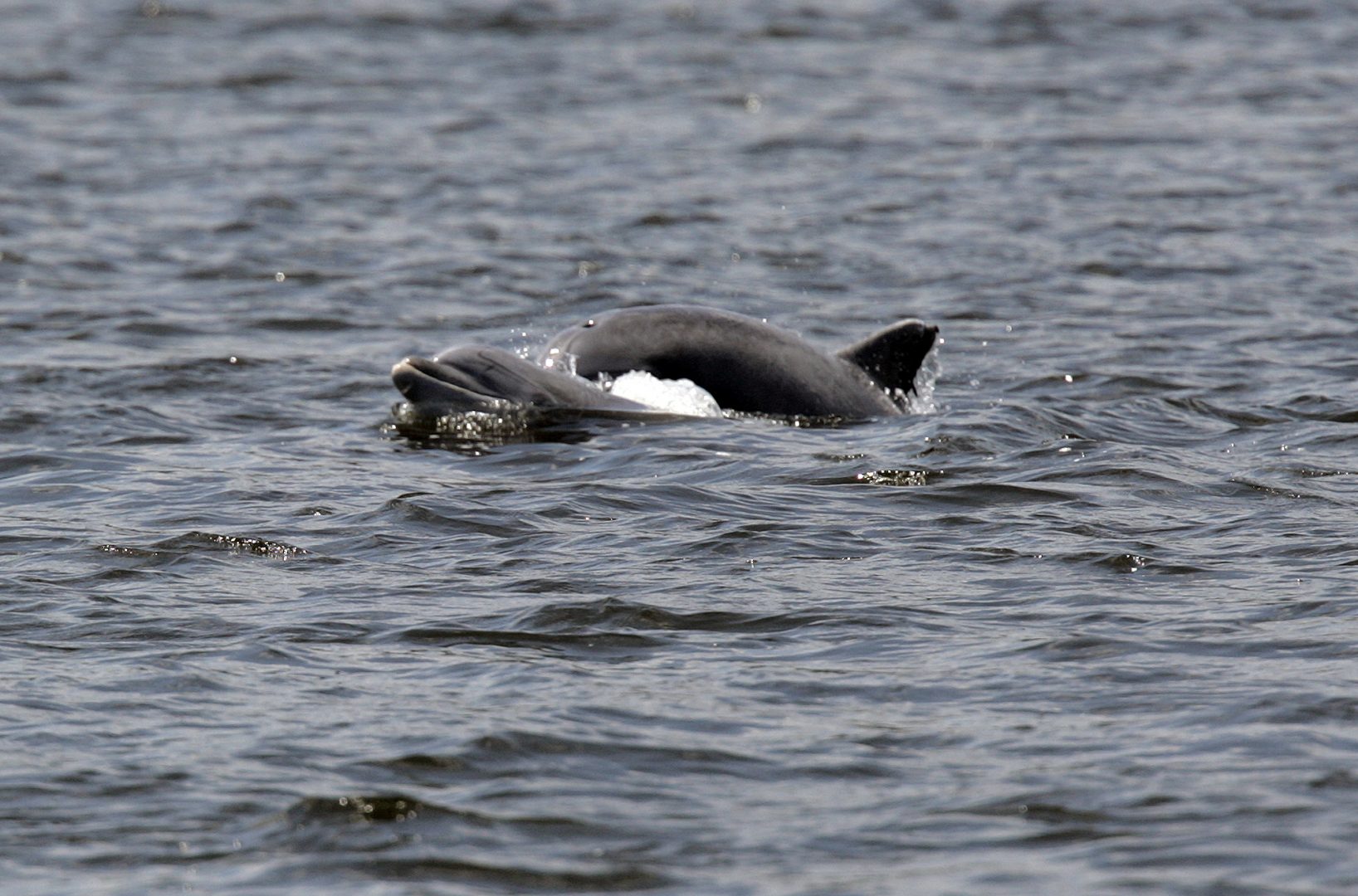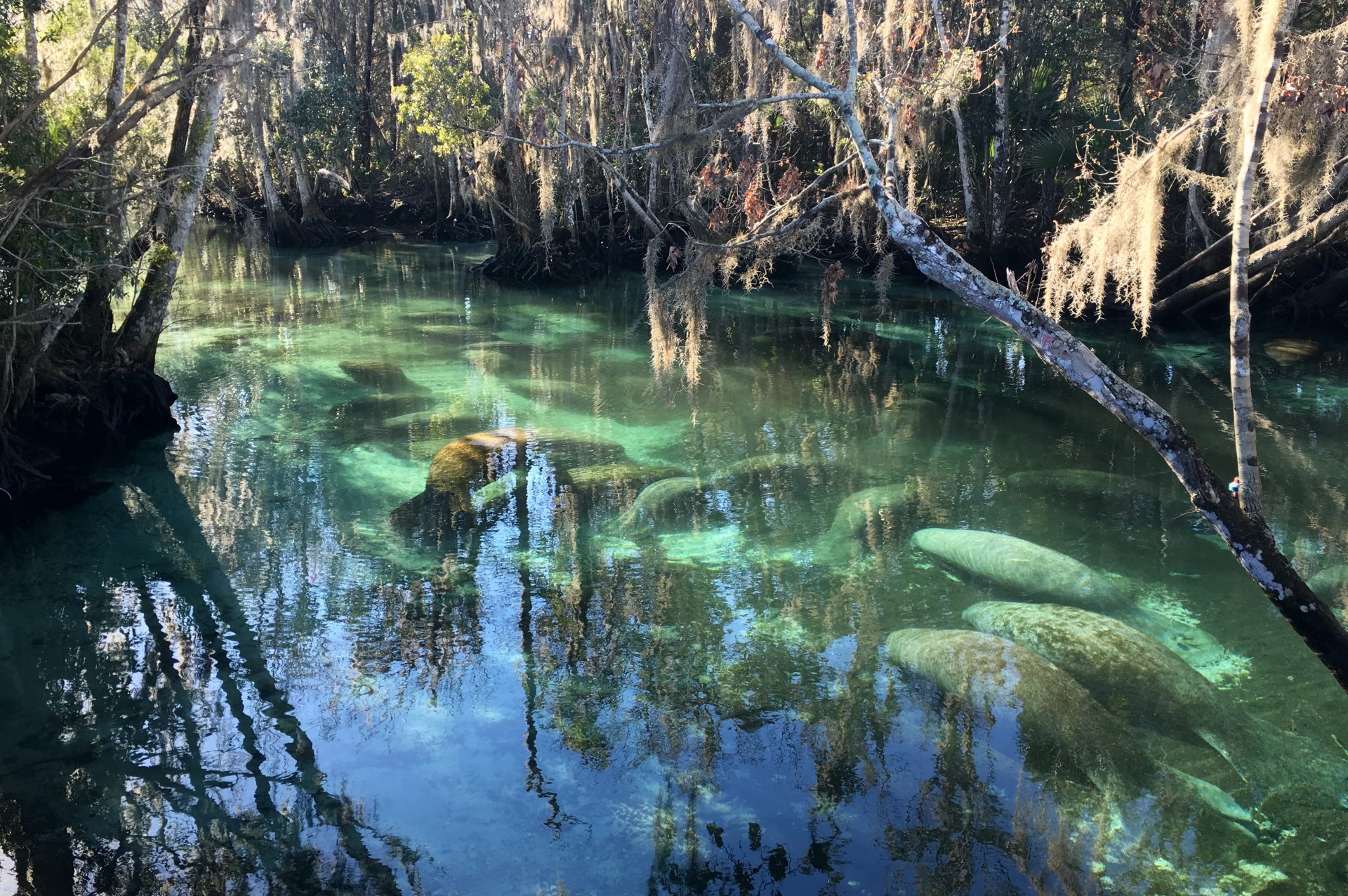
Dolphins swim in the Shrewsbury River Wednesday, July 2, 2008, in Sea Bright, N.J. (AP Photo/Mel Evans)


Dolphins swim in the Shrewsbury River Wednesday, July 2, 2008, in Sea Bright, N.J. (AP Photo/Mel Evans)

Mel Evans
Dolphins swim in the Shrewsbury River Wednesday, July 2, 2008, in Sea Bright, N.J. (AP Photo/Mel Evans)

Tamara Lush
Manatees crowd into 72-degree springs, seeking warmth from cold Gulf temperatures, Thursday, Feb. 11, 2016, at Three Sisters Springs in Crystal River Fla. Marine mammals like these manatees lack a gene that protects other mammals from limited exposures to a common class of pesticides known as organophosphates. (AP Photo/Tamara Lush)
Most mammals, including humans, can tolerate limited exposure to a commonly used class of pesticides known as organophosphates. Scientists believe that’s due to a special gene, Paraoxonase 1 (PON1). that exists in terrestrial mammals. The gene helps break down the toxicity of these insecticides, providing protection from the neurological disruption caused by organophosphates. Insects lack the gene, which is why organophosphates are so effective in killing them.
But a new report out today in the journal Science reveals that marine mammals, including manatees, whales, and dolphins lack the gene PON1 and could be harmed by these pesticides.
“We were originally assuming ‘Oh, all mammals are fine from these pesticides, they only hurt insects, they can’t hurt mammals because we have this gene that protects us,’” said Wynn K. Meyer, a postdoctoral associate at the University of Pittsburgh School of Medicine who studies evolutionary genetics and lead author on the study. “And we now know that that assumption isn’t correct.”
The pesticides runoff farmland into streams and eventually, make it to the ocean. When poisoned by high doses of organophosphates, humans experience a number of symptoms including brain damage, respiratory failure and in some cases death. Meyer said it’s too soon to know what exposure levels could impact marine mammals.
“The next step would be to collect more data on the concentrations of these pesticides that are getting into the water, in say Manatee habitats, at the peak of agricultural season,” Meyer said. “And then, we [need to] collect some samples from the manatees themselves to see whether they’ve been exposed and what kind of damage it’s doing.”
Manatees live in shallow and slow-moving waters, like rivers, estuaries or canals. In the U.S., they’re concentrated in Florida but migrate west and north in the summers. Some were seen in New Jersey waters and the Delaware Canal in 2015. They are considered threatened and are protected by federal law.
For marine biologist Amy D. Whitt, who studied the abundance and distribution of marine mammals in nearshore waters off the coast of New Jersey, the new report is a red flag. Her research confirmed the presence of eight species of marine mammals in New Jersey waters, including North Atlantic right whales, humpback whales, minke whales, fin whales, bottlenose dolphins, common dolphins, harbor porpoises and harbor seals.
“Due to their nearshore presence, these species could be exposed to concentrated levels of pesticides from agricultural runoff,” said Whitt, CEO of the environmental consulting firm Azura.
Meyer and senior author Nathan L. Clark, associate professor at University of Pittsburgh School of Medicine, stumbled upon this gene while comparing DNA sequences from five species of marine mammals and 53 species of terrestrial mammals. They were looking for genes that are very important for mammals living on land, but not important for those living in water, like the ones that allow us to have a sense of smell.
Marine mammals once lived on land — whales and dolphins share ancestors with the hippopotamus but evolved apart from them 53 million years ago, manatees split from elephants 64 million years ago — the marine mammals lost some genes as part of adaptation to their new environment.
“Evolution is fascinating and it sometimes has unintended consequences,” said Meyer. “So when this gene got turned off, it essentially lost what it was supposed to do, there weren’t any pesticides around — the loss had nothing to do with them. It mattered not a bit to the whales or the manatees 50 million years ago,” Meyer said. “Nowadays, it potentially makes a really huge difference.”
For Jason Somarelli, a cancer researcher and comparative medicine expert at Duke University, the study is fascinating not only because it finds that marine mammals could be susceptible to organophosphates, but also because it could lead to new discoveries of the use of PON1 for humans.
“I think the broader implication in my mind is how this now informs what the gene function is,” said Somarelli. He wonders if marine mammals have another gene that protects them from organophosphate poisoning. And if they do, further research on that gene could end up revealing information that helps human health.
Currently, the Environmental Protection Agency (EPA) is in the process of deciding whether to regulate the use of three organophosphate pesticides based on potential damage to threatened or endangered species.
StateImpact Pennsylvania is a collaboration among WITF, WHYY, and the Allegheny Front. Reporters Reid Frazier, Rachel McDevitt and Susan Phillips cover the commonwealth’s energy economy. Read their reports on this site, and hear them on public radio stations across Pennsylvania.
(listed by story count)
StateImpact Pennsylvania is a collaboration among WITF, WHYY, and the Allegheny Front. Reporters Reid Frazier, Rachel McDevitt and Susan Phillips cover the commonwealth’s energy economy. Read their reports on this site, and hear them on public radio stations across Pennsylvania.
Climate Solutions, a collaboration of news organizations, educational institutions and a theater company, uses engagement, education and storytelling to help central Pennsylvanians toward climate change literacy, resilience and adaptation. Our work will amplify how people are finding solutions to the challenges presented by a warming world.